Texas Flowers With Pictures (Native and Non-Native) – Identification Guide
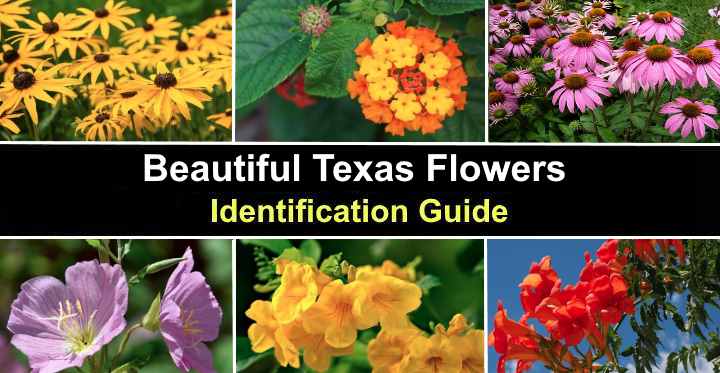
Native Texas flowers are perfect for brightening residential landscapes in hot, arid, dry climates. Flowers for growing in the Lone Star State typically bloom in spring and September, adding color, texture, and sweet fragrances to gardens. Additionally, Texas wildflowers are common throughout the state, transforming grasslands, plains, roadsides, and parks into a sea of blue, purple, pink, and white colors.
Growing blooming flowers can be challenging. For example, the winter temperatures of Armarillo in the Texas Panhandle are much colder than in San Antonio, Laredo, and Corpus Christi in Southern Texas. Additionally, some areas of Texas have a desert climate, making it challenging to grow flowers.
Thankfully, there are hundreds of native Texas flowers that thrive in the state. These wildflowers are adapted to the Texan landscape and climate, where they thrive in almost constant sunshine and warmth.
This article is an identification guide to some of the most popular Texas native plants. Descriptions and pictures of Texas wildflowers and cultivated flowers will help you choose the best ones for your garden landscape.
Whether you live in El Paso, Dallas, Galveston, or Lubbock, you will find flowers to enhance your garden aesthetics.
Flower Growing Zones in Texas
When choosing flowers to grow in a Texan landscape, it is vital to consider the USDA growing zone of your area. Many native Texas flowers are well-adapted to the year-long mild and warm climates of Central and Southern Texas. However, some perennials may struggle in the cold, freezing winters of Northern Texas.
Texas USDA hardiness zones range from 6 in the Panhandle to 9 on the Gulf Coast and the southern part of the Mexican border. Here is a short description of the growing zones in Texas:
USDA Zone 6: The Texas Panhandle including Armarillo. Average minimum temperatures -10°F to 0°F.
USDA Zone 7: Central Western Texas including Lubbock and El Paso. Average minimum temperatures are 0°F to 10°F.
USDA Zone 8: Central Eastern Texas including Cities like Dallas, Austin, San Antonio, and Houston. Average minimum temperatures are 10°F to 20°F.
USDA Zone 9: Southern Texas from just below San Antonio to the Gulf Coast. Cities in zone 9 include Laredo, Corpus Christi, and McAllen. Average minimum temperatures are 20°F to 30°F.
Common Wildflowers in Texas
The most common Texas wildflower is the Bluebonnet (Lupinus texensis) — which also happens to be the state flower of Texas. Other flowers in the Lone Star State that grow wild include prickly pear cactus (Opuntia), Mexican hat (Ratibida columnaris), Texas sage (Texas lantana), and winecup (Callirhoe involucrata).
Texas Flowers to Grow in Your Garden (With Pictures)
There are many native flowers for Texan landscapes that grow as annuals or perennials. You can also plant Texas wildflowers in your front or backyard to give your garden landscape a more natural look. Let’s look in detail at some of the best native and non-native Texas flowers to plant in your garden.
Texas Bluebonnet (Lupinus texensis)

Texas Bluebonnet (Lupinus texensis)
Bluebonnet is native Texas wildflower with flowering spikes of bright blue to purple pea-like flowers. Around 50 dainty blue flowers make up the flower clusters, blooming on erect stems in early to late spring. This Texas State flower thrives throughout the state, turning fields, roadsides, and plains into vibrant colors.
Bluebonnet grows 12” to 18” (30 to 45 cm) tall and wide. You can plant the winter-hardy annual as flower borders or add color and texture to a cottage garden. The blue-flowering plant thrives in full sun and well-drained soils. It is also tolerant of drought and can survive in arid climates.
USDA Growing Zones: 4 to 8.
Sun Exposure: Full sun.
Height and Width: 12” to 18” (30 – 45 cm) tall and wide.
Black-Eyed Susan (Rudbeckia hirta)
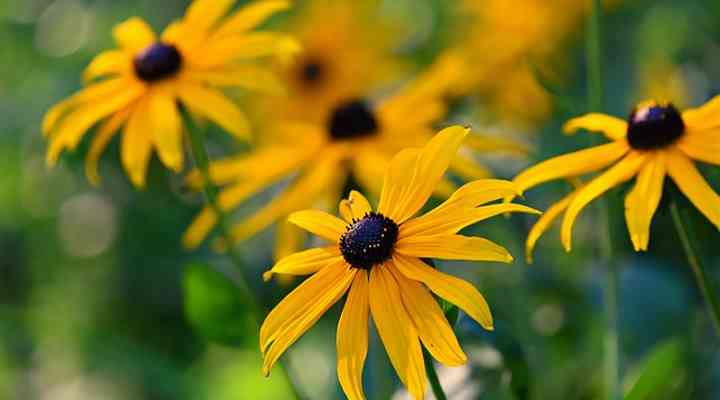
Black-Eyed Susan (Rudbeckia hirta)
Black-eyed Susan is a native Texas wildflower with large, brightly colored yellow daisy-like blooms. These tall yellow flowers grow on long, erect stems, creating a blanket of golden yellow colors. The yellow linear petals surround a dark brown disc in the center. The heat and drought-tolerant flowers bloom from early summer to fall.
Black-eyed Susan is a self-seeding, short-lived perennial for full sun. The large disc-shaped flowers measure 3” (7.5 cm) wide, and lance-shaped leaves 3” to 7” (7.5 – 17 cm). This easy-to-grow native plant is suitable for mixed borders, cottage gardens, or the back of a flower bed.
USDA Growing Zones: 3 to 10.
Sun Exposure: Full sun.
Height and Width: 24” to 36” (60 – 90 cm) tall and 12” to 24” (30 – 60 cm) wide.
Purple Coneflower (Echinacea purpurea)

Purple Coneflower (Echinacea purpurea)
Purple coneflower is a spectacular perennial with large, showy purple flowers growing on tall stems. The eye-catching native Texas flowers have drooping rays dangling from a prominent dark brown central cone. The drought and heat-tolerant plant also has dark-green, lanceolate leaves. Growing in mass plantings, the flowers turn landscapes into attractive purple hues.
Purple coneflower is a clumping flowering plant with vigorous growth. Growing in well-drained soils and full sun, the tall flowers are perfect for growing in beds and borders, cottage gardens, or adding height to a flower bed. Coneflowers also make excellent cut flowers.
USDA Growing Zones: 3 to 8.
Sun Exposure: Full sun.
Height and Width: 24” to 60” (60 – 150 cm) tall and up to 24” (60 cm) wide.
Rock Rose (Pavonia lasiopetala)
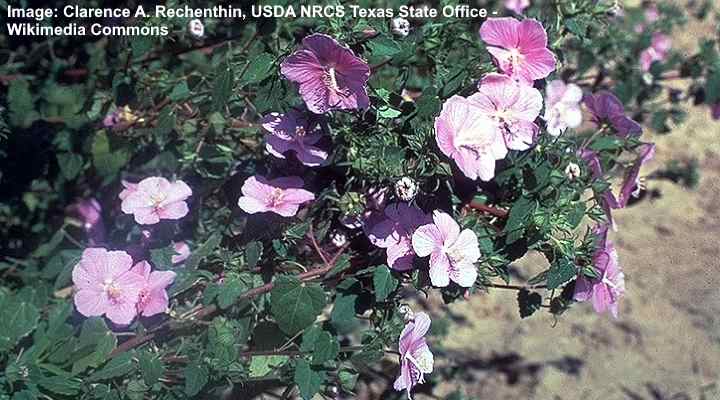
Rock Rose (Pavonia lasiopetala)
Rock rose is a small native Texas flowering shrub with pink flowers consisting of papery petals. The heat-loving, full-sun perennial flowers have five petals with a prominent pale pink stamen and look like small hibiscus flowers. The vigorous, spreading shrub also has leaves with toothed or lobed margins.
Also called Texas swamp mallow, this flowering plant thrives in dry, arid conditions. The low-growing, spreading plant is ideal for pink-flowering ground cover blooms from June through summer until late fall.
USDA Growing Zones: 8 and 9.
Sun Exposure: Full sun or part shade.
Height and Width: Up to 48” (120 cm) tall and wide.
Crossvine (Bignonia capreolata)
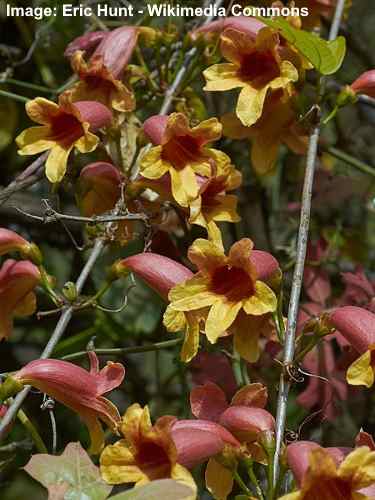
Crossvine (Bignonia capreolata)
Crossvine is a native vining plant with multi-colored, trumpet-shaped spring flowers. Thriving through Texas from Amarillo to San Antonio, this climbing vine blooms in red, yellow, and orange colors for up to four weeks. The showy flowers contrast with the lance-shaped, glossy dark-green leaves. When blooming, the scrambling vine is covered in masses of reddish flowers.
Crossvine is a free-flowering native plant ideal for flowering ground cover in full sun or as a climber. The fast-growing, woody vines have 2” (5 cm) long flowers. These fragrant blossoms look spectacular, covering arbors, pergolas, and trellises. Unfortunately, the flowering vine requires constant pruning to prevent it from taking over your garden.
USDA Growing Zones: 6 to 9.
Sun Exposure: Full sun or part sun.
Height and Width: 30 to 50 ft. (9 – 15 m) tall and 6 to 9 ft. (1.8 – 2.7 m) wide.
Related reading: Vining plants with purple flowers.
Lemon Beebalm (Monarda citriodora)
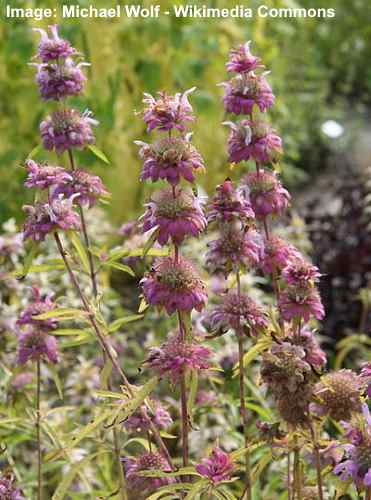
Lemon Beebalm (Monarda citriodora)
Also called purple horsemint, lemon beebalm is a sun-loving flowering plant with dainty pinkish-purple or lavender tubular flowers. The fragrant purple flower clusters grow in groups of two to six on a stem. The purple flowers contrast nicely with the lanceolate leaves that have a lemony or citrus scent when crushed.
Lemon beebalm is a cold-hardy, drought-tolerant plant that blooms throughout summer. You can plant the attractive flowers in herb gardens or along a border.
USDA Growing Zones: 2 to 11.
Sun Exposure: Full sun, partial shade.
Height and Width: 12” to 36” (30 – 90 cm) tall and 9” to 12” (22 – 30 cm) wide.
Texas Lantana (Lantana urticoides)
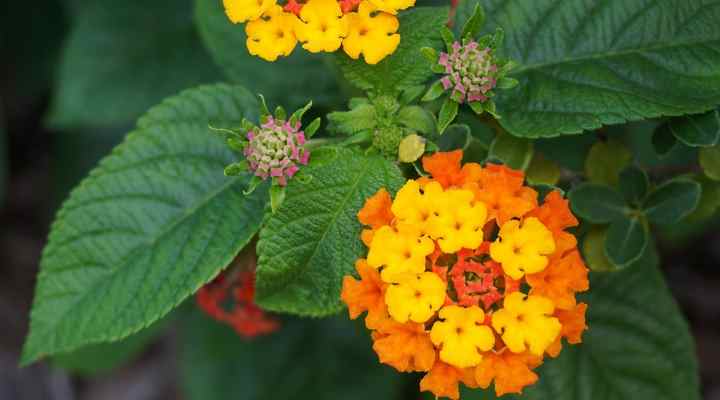
Texas Lantana (Lantana urticoides)
Texas lantana is an attractive spreading, mounding shrub with brightly colored yellow and orange-reddish flowers. The tubular flowers grow in rounded clusters and turn arid Texas desert landscapes into a mass of bright colors. The showy flowers contrast with the large, broadly ovate leaves that give off an aromatic scent.
Also called calico bush, Texas Lantana is an excellent outdoor Texas plant that thrives in hot summers and withstands cooler winters. The long-blooming shrub is ideal for growing as yellow-flowering ground cover or for brightening beds and borders.
USDA Growing Zones: 8 to 11.
Sun Exposure: Full sun.
Height and Width: 24” to 36” (60 – 90 cm) tall and 4 to 6 ft. (1.2 – 1.8 m) wide.
Texas Indian Paintbrush (Castilleja indivisa)
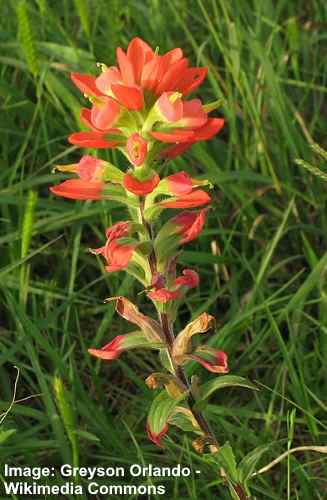
Texas Indian Paintbrush (Castilleja indivisa)
Texas Indian paintbrush is a red-flowering native plant that blooms during spring. The red flowers are actually bright red leaf-like bracts around tiny greenish flowers. The flowering spikes give the appearance of being dipped in red paint. The low-maintenance sun-loving plants for Texas landscapes look spectacular growing alongside native Texas bluebonnets.
This annual or biennial colorful plant thrives in dry, sandy, acidic, well-draining soils. The plant looks best growing in mass plantings in informal gardens or meadows.
USDA Growing Zones: 6 to 11.
Sun Exposure: Full sun.
Height and Width: 6” to 24” (15 – 60 cm) tall and 5” to 6” (12 – 15 cm) wide.
Trumpet Creeper (Campsis radicans)
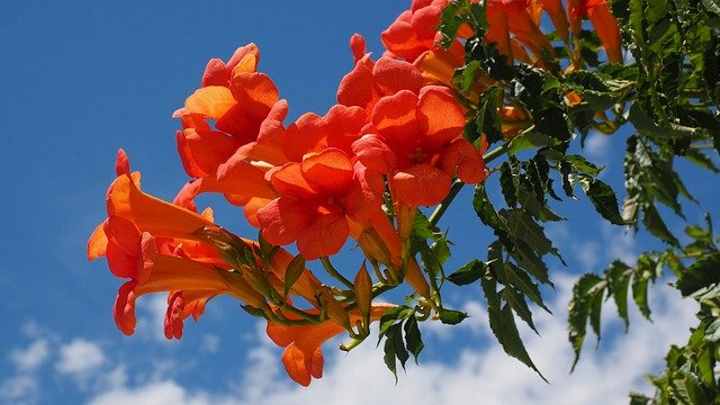
Trumpet Creeper (Campsis radicans)
Trumpet creeper is a vigorous red-flowering vine with terminal clusters of showy funnel-shaped flowers. The trumpet flowers are bright shades of red or orange and measure 3” (7.5 cm) long. The aggressive climbing vine has glossy, dark green leaves and clings to any surface — stone, brick, and wood — quickly covering it with green foliage and orange-reddish flowers.
This hardy, easy-to-grow vine spreads rapidly in Texas landscapes. It can cover arbors and retaining walls or grow as fast-growing full-sun ground cover. It’s also good for preventing soil erosion on slopes. Bloom time is during summer, and it is cold, heat, and drought-tolerant.
USDA Growing Zones: 5 to 9.
Sun Exposure: Full sun, partial shade.
Height and Width: 20 to 40 (6 – 12 m) tall and 5 to 10 ft. (1.5 – 3 m) wide.
Winecup (Callirhoe involucrata)
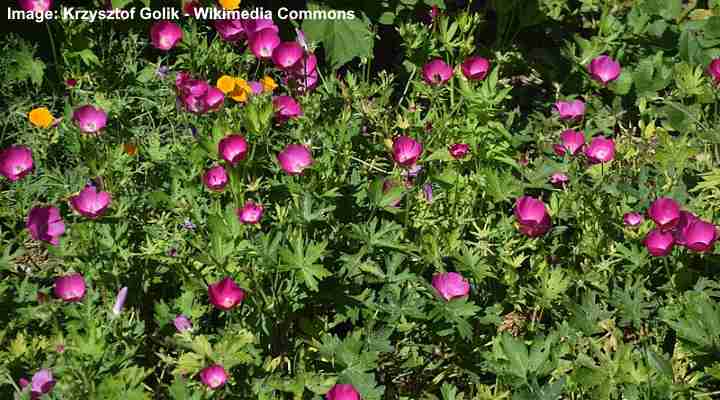
Winecup (Callirhoe involucrata)
Winecup is a ground-hugging perennial that thrives in Texas desert landscapes, prairies, and along semi-arid roadsides. The identifying feature of winecup perennials is the five-petaled, cup-shaped purple-magenta flowers that bloom continuously from spring for several months. Grow as mat-forming ground cover or to add color and texture to foundation plantings.
Also called purple poppy mallow, the spreading landscaping plant is ideal for growing in North and Central Texas,
USDA Growing Zones: 4 to 8.
Sun Exposure: Full sun.
Height and Width: 6” to 12” (15 – 30 cm) tall and 6” to 36” (15 – 90 cm) wide.
Heartleaf Rosemallow (Hibiscus martianus)
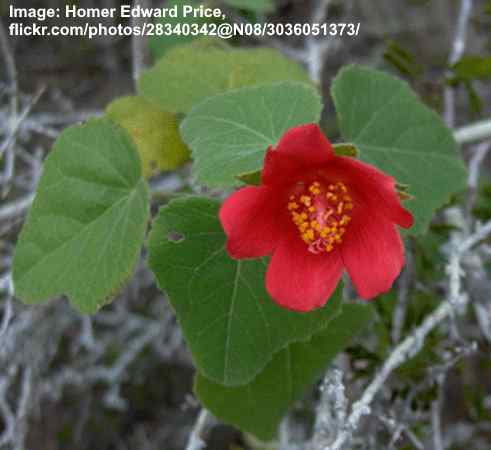
Heartleaf Rosemallow (Hibiscus martianus)
Exotic heartleaf rosemallow hibiscus is an attractive landscape plant for central and southern Texan landscapes. This drought-tolerant plant is famed for its tropical funnel-shaped crimson-red flowers that bloom all summer. As the name suggests, the low-growing shrub has green cordate (heart-shaped) leaves. The eye-catching red flowers attract pollinators to summer gardens.
Heart-leaf hibiscus blooms throughout the year in frost-free locations. It is drought and heat-tolerant and ideal for planting in dry, arid landscapes and xeriscaping.
USDA Growing Zones: 8 to 10.
Sun Exposure: Full sun, partial shade.
Height and Width: 12” to 36” (30 – 90 cm) tall and wide.
Related reading: How to care for tropical hibiscus shrubs.
Texas Sage (Leucophyllum frutescens)

Texas Sage (Leucophyllum frutescens)
Texas sage is a bushy shrub that thrives in eastern Texas south of Dallas to the Gulf of Mexico. The identifying features of the small shrub are purple, pink, violet, or lavender flowers, tiny silver-gray leaves, and a mounding habit. This evergreen flowering shrub blooms throughout the year in warm climates.
Also called the Texas ranger and Texas barometer bush, the shrub has the title “State Native Shrub of Texas.” It is perfect as a foundation planting, evergreen hedge, border, or container plant. It grows best in warm climates with low humidity.
USDA Growing Zones: 8 to 10.
Sun Exposure: Full sun.
Height and Width: 5 to 8 ft. (1.5 – 2.4 m) tall and 4 to 6 ft. (1.2 – 1.8 m) wide.
Flame Acanthus (Anisacanthus quadrifidus)

Flame Acanthus (Anisacanthus quadrifidus)
Flame acanthus is a deciduous shrub with slender stems, lanceolate leaves, and vibrant bright-red tubular flowers. Suitable for growing in all areas of Texas apart from the Panhandle, this attractive flowering shrub is popular for its ornamental blooms, perennial growth, and tolerance to drought and dry soils.
This upright, heat-tolerant exotic shrub is perfect for a summer hedge, mixed flower bed, foundation planting, or cottage garden.
USDA Growing Zones: 7 to 10.
Sun Exposure: Full sun and partial shade.
Height and Width: 3 to 5 ft. (1 – 1.5 m) tall and wide.
Yellow Bells (Tecoma stans)

Yellow Bells (Tecoma stans)
Yellow bells is a beautiful ornamental shrub with brightly colored, trumpet-shaped yellow blooms. The fast-growing shrub has large clusters of yellow flowers that bloom continuously from spring through frost. However, in Southern Texas, it produces yellow blossoms dangling from arching stems throughout the year.
This landscaping shrub is ideal for Texas because it tolerates full sun and dry, fertile soils. For its spectacular yellow floral displays, you can plant the yellow-flowering bush as a shrub border, specimen plant, or container plant.
USDA Growing Zones: 9 to 11.
Sun Exposure: Full sun, partial shade.
Height and Width: 3 to 25 ft. (1 – 7.6 m) tall and up to 20 ft. (6 m) wide.
Indian Blanket (Gaillardia pulchella)
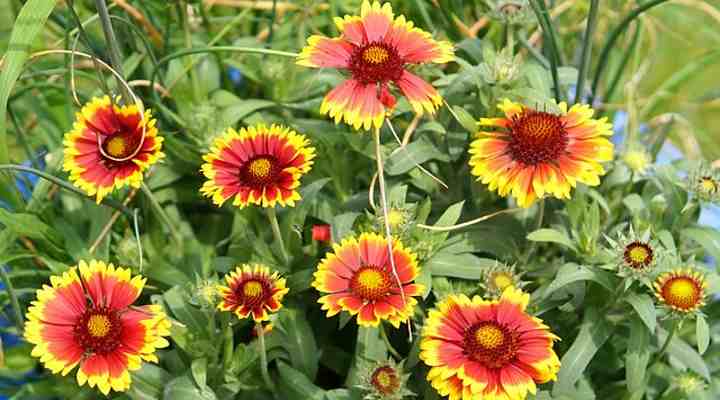
Indian Blanket (Gaillardia pulchella)
Indian blanket is a showy short-lived perennial with eye-catching yellow-tipped red daisy-like flowers. The large disc and ray flowers face upward on the ends of erect stems. From spring through fall throughout Texas, the drought-tolerant plant creates a mass of red and yellow colors in full sun and poor, dry soils.
Also called Firewheel, you will often see this Texas wildflower growing along roadsides, plains, and prairies. In addition, many varieties of Indian blanket flowers are popular for cultivation to add color to Texas residential landscapes.
USDA Growing Zones: 2 to 11.
Sun Exposure: Full sun.
Height and Width: 12” to 24” (30 – 60 cm) tall and 6” to 12” (15 – 30 cm) wide.
Crepe Myrtle (Lagerstroemia indica)
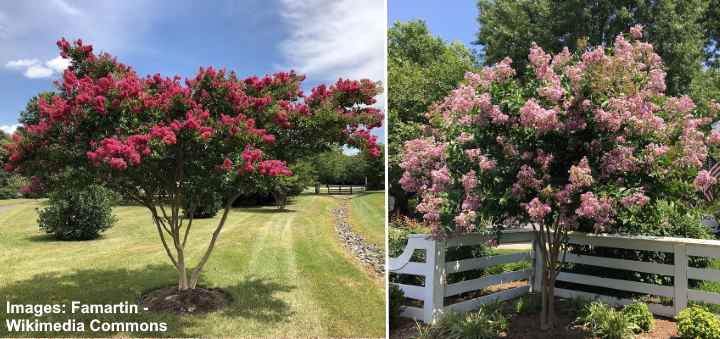
Crepe Myrtle (Lagerstroemia indica)
Crepe myrtle is a flowering multi-trunked plant that blooms with masses of red, pink, white, and purple flowers. This large flowering shrub looks stunning when covered in abundant clusters of ruffled flowers that persist on the tree for several months. The attractive ornamental shrub-like tree has thick leathery green leaves that turn orange-brown in the fall.
Purple-flowering crape myrtle is ideal for Texas landscapes throughout the entire state. The drought and pollution-tolerant plant thrives in most types of well-draining soils.
USDA Growing Zones: 6 to 9.
Sun Exposure: Full sun.
Height and Width: 6 to 12 ft. (1.8 – 3.6 m) tall and wide.
Desert Willow (Chilopsis linearis)
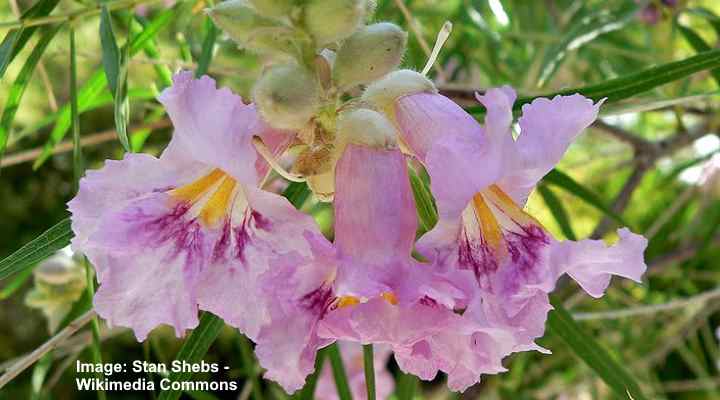
Desert Willow (Chilopsis linearis)
Desert willow is a large deciduous flowering shrub, ideal for growing in all regions of Texas apart from the Panhandle. This fast-growing, drought-tolerant plant has masses of trumpet-shaped pale pink to pale violet flowers that give off a sweet fragrance. This native plant also has shaggy bark, gnarled branches, and bean-like pods, giving it a visual appeal during winter.
Desert willow is suitable for planting as an eye-catching ornamental shrub for its long-lasting pink blossoms and attractive rounded, spreading crown.
USDA Growing Zones: 7 to 11
Sun Exposure: Full sun
Height and Width: 15 to 30 ft. (4.5 – 9 m) tall and 10 to 20 ft. (3 – 6 m) wide.
Purple Lily Magnolia (Magnolia liliiflora)
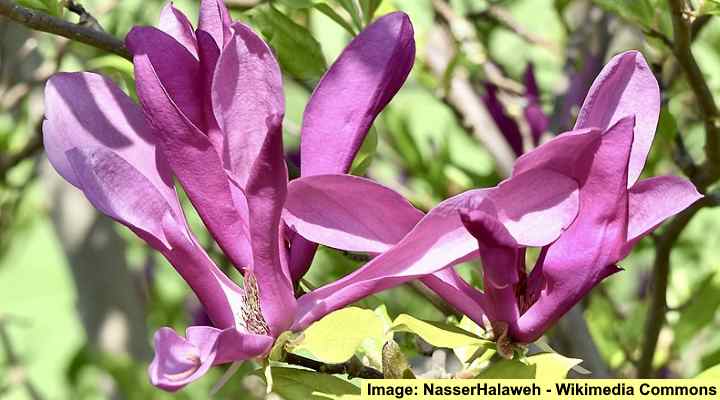
Purple Lily Magnolia (Magnolia liliiflora)
The purple lily magnolia produces spectacular pink-purple flowers in spring and early summer in Texan landscapes. The non-native Texas plant has flowers that look like upward-pointing tulips or lily flowers and cover branches when in bloom throughout spring. The deep, lustrous green leaves create beautiful foliage on its rounded crown and spreading branches.
This large multi-trunked plant creates a stunning focal point in a southern garden landscape. You can also prune the suckering stems to grow a flowering ornamental lawn tree or backyard tree in a Texan garden anywhere from Amarillo to Dallas, Huston, or Corpus Christi.
USDA Growing Zones: 5 to 9.
Sun Exposure: Full sun or partial shade.
Height and Width: 8 to 12 ft. (2.4 – 3.6 m) tall and wide.
Related articles: Magnolia Trees and Shrubs: Care and Growing Guide.
Texas Redbud (Cercis canadensis var. texensis)

Texas Redbud (Cercis canadensis var. texensis)
If you want to grow a small purple-flowering tree in Texas, the Texas redbud is a perfect choice. The small ornamental heat-tolerant tree has spectacular pink to purple decorative flowers covering bare branches in spring. Large kidney-shaped leaves appear after flowering and persist until fall when they turn golden yellow.
The Texas variety is more tolerant of heat than other redbud shrubs and trees. The drought-tolerant small flowering tree thrives in dappled shade or full sun and its glossy, rounded leaves provide shade for small shrubs and plants.
USDA Growing Zones: 6 to 9.
Sun Exposure: Full sun or dappled sunlight.
Height and Width: 25 to 30 ft. (15 – 25 m).
Dwarf Mexican Petunia (Ruellia brittoniana)
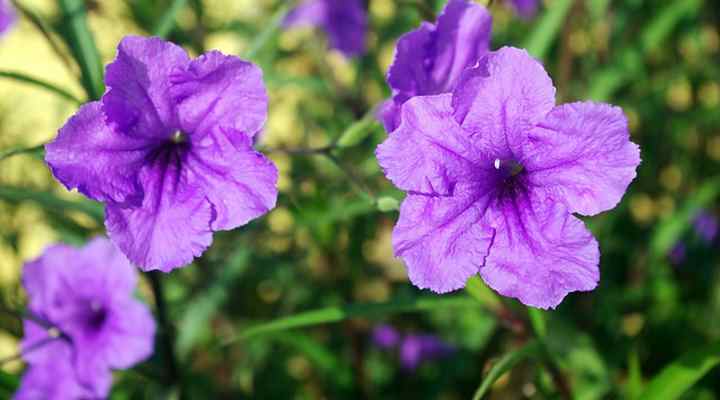
Dwarf Mexican Petunia (Ruellia brittoniana)
Dwarf Mexican petunia produces vibrant purple trumpet-shaped flowers and lanceolate, glossy green leaves. Mexican petunias have all the qualities to thrive in harsh Texan landscapes. The flowers and foliage tolerate humidity, dry air, heat, and drought. However, Mexican petunia flowers can become difficult to control in the hottest regions of Texas.
One of the benefits of growing flowering dwarf Mexican petunia in Texas is that it tolerates wet, soggy soil as well as drought conditions. As a result, its tubular purple flowers typically bloom freely from May through September.
The flowers also go by the names Florida bluebells, desert petunias, and Mexican bluebells.
USDA Growing Zones: 8 to 10.
Sun Exposure: Full sun or partial shade.
Height and Width: 24” to 36” (60 – 90 cm) tall and 12” to 24” (30 – 60 cm) wide.
Anise Hyssop (Agastache foeniculum)
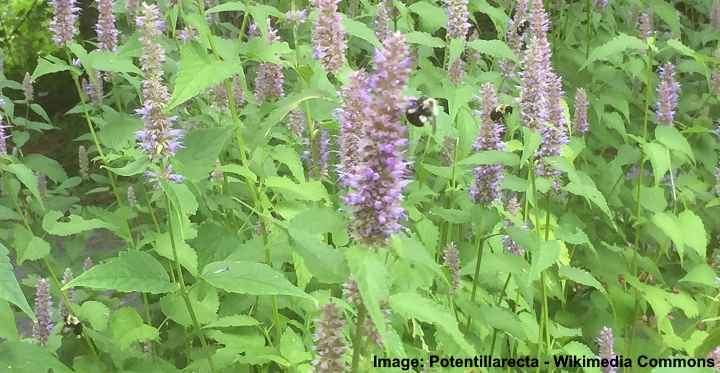
Anise Hyssop (Agastache foeniculum)
Anise hyssop is a clump-forming flowering plant suitable for planting in Texas north of San Antonio and Houston. The summer-perennial flowers are fuzzy conical spikes consisting of small, tubular purple flowers that last until fall. The plant features aromatic, licorice-scented foliage and its fragrant flowers attract bees and pollinators.
Anise hyssop is an ideal plant to grow in Texas in informal landscapes, herb gardens, or to add height to the back of flower beds.
USDA Growing Zones: 4 to 8.
Sun Exposure: Full sun.
Height and Width: 12” to 18” (30 – 45 cm) tall and 18” to 36” (45 – 90 cm) wide.
Mexican Oregano (Poliomintha longiflora)

Mexican Oregano (Poliomintha longiflora)
Mexican oregano is a herbaceous flowering perennial shrub that thrives in Central and Southern Texas. The characteristics of this shrubby plant are its small, glossy, aromatic leaves, lavender-pink tubular flowers, and clumping habit. This plant is native to Mexico but is grown throughout Texas for its oregano-like edible foliage.
In Northern Texas, Mexican oregano is best grown in containers to overwinter indoors. However, south of San Antonio, the semi-evergreen culinary shrub grows in the ground throughout the year. Bloom time is summer and fall.
USDA Growing Zones: 4 to 8.
Sun Exposure: Full sun.
Height and Width: 36” to 47” (90 – 120 cm) tall and wide.
Texas Bluebell (Eustoma grandiflorum)
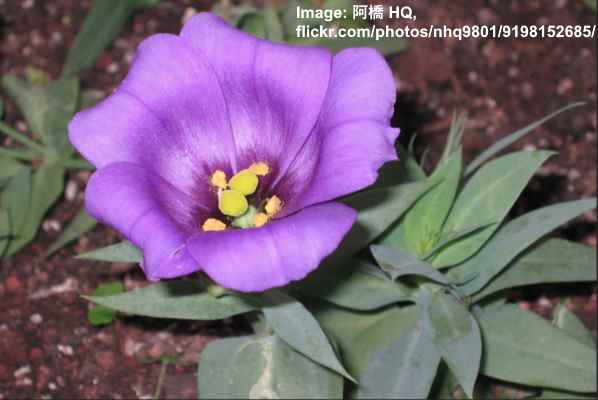
Texas Bluebell (Eustoma grandiflorum)
Texas bluebell is a flowering biennial plant with large purple bell-shaped flowers. The showy purple flowers measure 2” (5 cm) across, and some cultivars have double blooms. Its leaves are ovate-shaped and are 3” (7.5 cm) long. Varieties of Texas bluebell flowers also come in violet, white, and pink shades.
Growing Texas bluebells in southern states is ideal for adding purple-flowering ground cover to your yard. The spreading plant is also suitable in beds, borders, and dwarf Texas bluebell plants are ideal for containers.
USDA Growing Zones: 8 to 10.
Sun Exposure: Full sun.
Height and Width: 12” to 36” (30 – 90 cm) tall and 8” to 12” (22 – 30 cm) wide.
Gayfeather (Liatris mucronata)
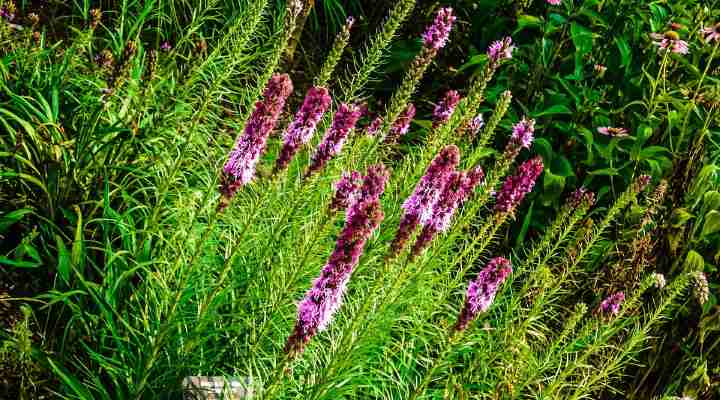
Gayfeather (Liatris mucronata)
Also called Texas blazing star, this purple-flowering perennial has tall flowering spikes with fuzzy rose-pink to purple blooms. The clump-forming plant has grassy foliage, creating a spectacular floral display during late summer and fall. The native plant is suited to growing in Texas’s sandy soil and summer heat.
Gayfeather thrives in full sun and is tolerant of drought. The tall spikes of dense conical clusters create a strong vertical accent in Texan gardens. You can also grow the plant in perennial borders, rock gardens, or containers.
USDA Growing Zones: 6 to 9.
Sun Exposure: Full sun.
Height and Width: 12” to 36” (30 – 90 cm) tall and up to 24” (60 cm) wide.
Sweet Alyssum (Lobularia maritima)
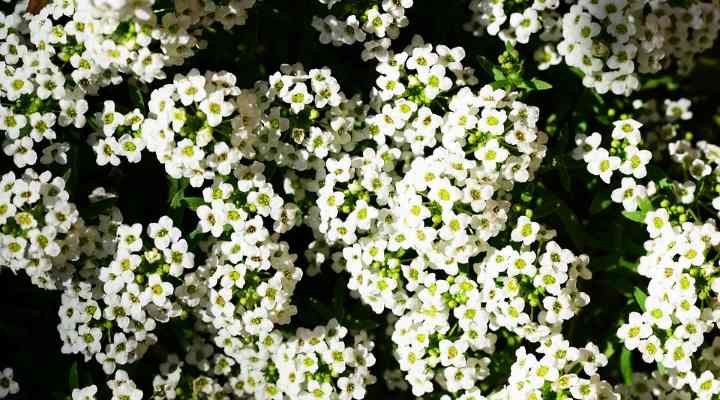
Sweet Alyssum (Lobularia maritima)
Sweet alyssum is a white-flowering, mat-forming plant that is easy to grow in all Texas growing zones. The spreading plant is covered in small pure white fragrant flowers that create a white carpet of snow-like cover. The mounding plant also has linear leaves; however, they are rarely seen under the mounds of white flowers.
Other varieties of sweet alyssum have flowers with shades of rose, dark red, purple, apricot, and pink. The flowers are ideal for Texas landscapes to create colorful bedding, border fronts, rock gardens, or ground cover.
USDA Growing Zones: 2 to 11.
Sun Exposure: Full sun or partial shade.
Height and Width: 6” to 12” (15 – 30 cm) tall and 10” to 24” (25 – 60 cm) wide.
Dianthus (Dianthus caryophyllus)
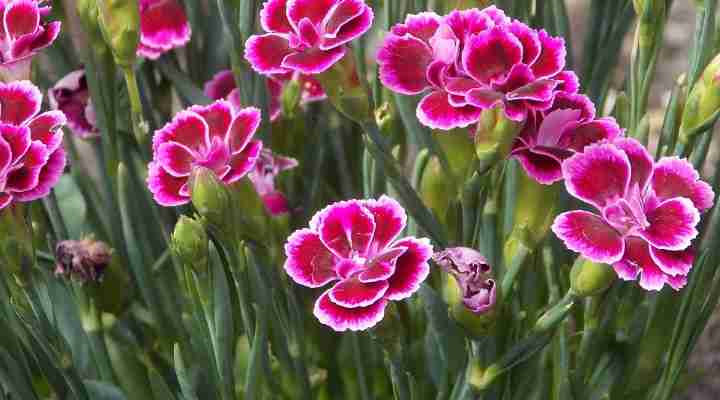
Dianthus (Dianthus caryophyllus)
Dianthus — also called carnations — are known for their showy flowers with colorful ruffled petals on the ends of long stems. Dianthus plants also have waxy dark green strap-like leaves that measure 3” to 6” (7.5 – 15 cm) long. In the hottest areas of Texas, carnation flowers need more watering to withstand the intense summer heat.
Dianthus is a group of flowers that add color and sweet aromas to garden landscapes. In addition, the tall flowers make excellent cut flowers to add to indoor floral displays. There are many cultivars to choose from with a variety of colors including pink, purple, red, white and yellow.
USDA Growing Zones: 6 to 9.
Sun Exposure: Full sun or partial shade.
Height and Width: 1 to 4 ft. (0.3 – 1.2 m) tall and 6” to 12” (15 – 30 cm) wide.
Zinnia (Zinnia elegans)
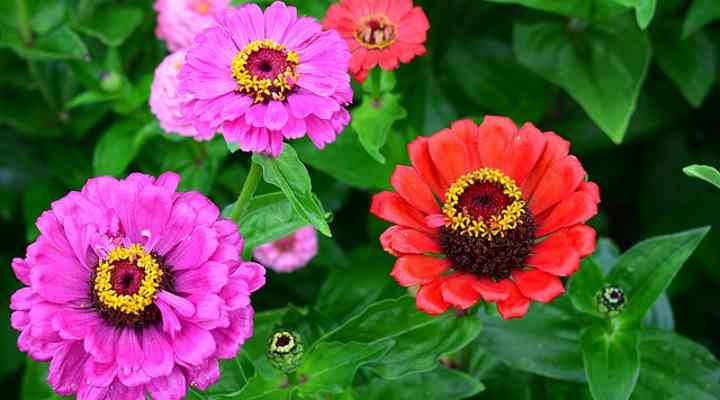
Zinnia (Zinnia elegans)
Zinnia flowers are prized in Texas gardens because of their large, showy, colorful blooms. The huge pink, purple, red, apricot, and yellow flowers can measure up to 6” (15 cm) in diameter. Some of the most outstanding flowers are double flowers packed with hundreds of colorful petals.
Zinnia flowers have a long blooming time in Texan landscapes. The easy-to-grow flowers are durable and tolerate drought, humidity, and heat. There are hundreds of varieties of zinnias to choose from, some with star-shaped disc flowers, ray flowers, or flowers with composite heads.
USDA Growing Zones: 2 to 11.
Sun Exposure: Full sun.
Height and Width: 1 to 4 ft. (0.3 – 1.2 m) tall and wide, depending on the cultivar.
Turk’s Cap (Malvaviscus arboreus)
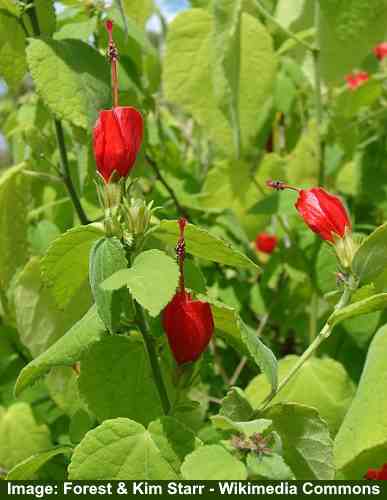
Turk’s Cap (Malvaviscus arboreus)
Turk’s cap is a shade-loving flowering shrub native to Texas. The perennial Texas shade plant blooms with abundant red flowers in part shade to deep shade. The small shrub has tubular flowers that bloom from late spring through summer until fall. These red flowers are followed by red berries that have an apple-like taste.
Turk’s cap has heart-shaped, evergreen leaves in mild winter climates. As a result, the shrub thrives throughout Texas, apart from the regions around Armallio. To add color and texture to your garden landscape, you can plant the flowering ornamental shrub in a shade garden.
USDA Growing Zones: 7 to 10.
Sun Exposure: Partial shade to full shade.
Height and Width: 2 to 5 ft. (0.6 – 1.5 m) tall and wide.
Pigeonberry (Rivina humilis)

Pigeonberry (Rivina humilis)
Also called bloodberry, pigeonberry is a small perennial shrub with year-long white to pink blooms in Texas. The small delicate blossoms give way to brightly colored red berries that contrast nicely with the elliptic to ovate leaves dangling on long petioles. This drought-tolerant shrub is suitable for growing in the shade in Texas landscapes.
Pegeonberry is a fast-growing shrub for southern gardens. You can plant it as a specimen plant or foundation planting. Additionally, it grows as a flowering ground cover for shaded gardens.
USDA Growing Zones: 7 to 11.
Sun Exposure: Partial shade to full shade.
Height and Width: 3 to 5 ft. (1 – 1.5 m) tall and 1 to 3 ft. (0.3 – 1 m wide).
Wildflowers in Texas (With Pictures)
Texas wildflowers are some of the most spectacular flowers in the landscape. The most common wildflower in the Lone Star state is the Texas bluebonnet which covers the ground with blue flowers during spring and summer. However, many other eye-catching flowers in Texas grow in the wild.
Drummond Phlox (Phlox drummondii)
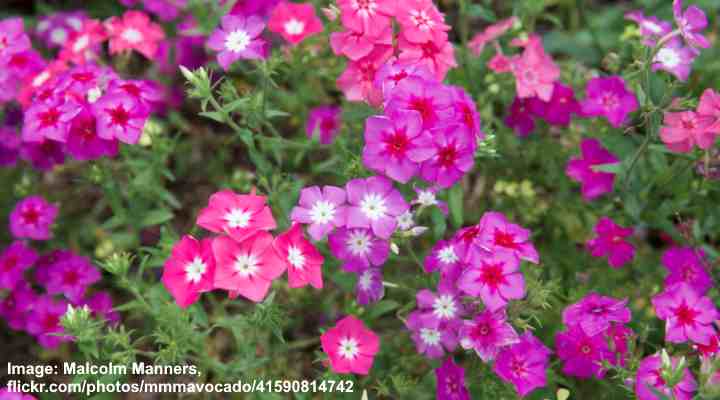
Drummond phlox (Phlox drummondii)
Also called annual phlox, this mat-forming hardy Texas wildflower explodes into purple and pink colors in early spring. The deep pink to purple attractive flowers have five petals in the shape of a star. The annual plant is common in prairies, meadows, and along roadsides.
Grow Drummond phlox in flower beds, hanging baskets, rock gardens, or along a foundation line.
USDA Growing Zones: 2 to 11.
Sun Exposure: Full sun or partial sun.
Height and Width: 6” to 12” (15 – 30 cm) tall and wide.
Pink Evening Primrose (Oenothera speciosa)
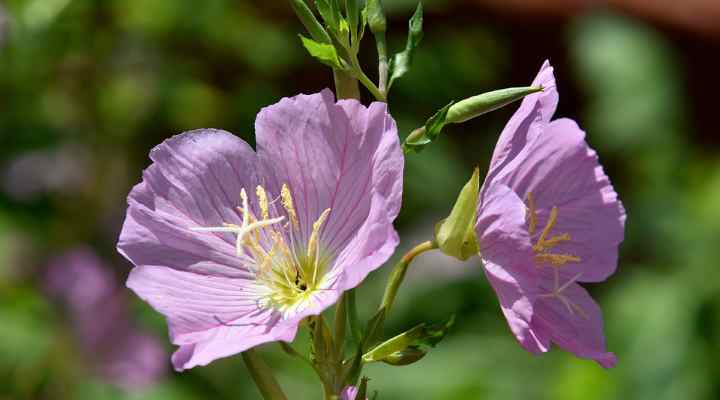
Pink Evening Primrose (Oenothera speciosa)
Pink evening primrose is a common wildflower blooming throughout northern Texas. The pale pink fragrant bowl-shaped flowers have whitish-yellow centers and deep pink veins. These pretty flowers bloom from late spring until early fall and typically open in the evening.
Pink evening primrose is ideal for full-sun ground cover in Texas gardens. The flowering perennials also grow well in beds, borders, and rock gardens.
USDA Growing Zones: 4 to 9.
Sun Exposure: Full sun.
Height and Width: 10” to 24” (25 – 60 cm) tall and wide.
Mexican Hat (Ratibida columnaris)

Mexican Hat (Ratibida columnaris)
Mexican hat is a colorful Texas wildflower blooming during May and June throughout the state. The eye-catching flowers have yellow and red drooping rays around a columnar center — giving the flower the appearance of a Mexican sombrero. The attractive clump-forming perennial looks stunning growing in sunny borders.
USDA Growing Zones: 4 to 9.
Sun Exposure: Full sun.
Height and Width: 12” to 36” (30 – 90 cm) tall and 12” to 24” (30 – 60 cm) wide.
Blackfoot Daisy (Melampodium leucanthum)
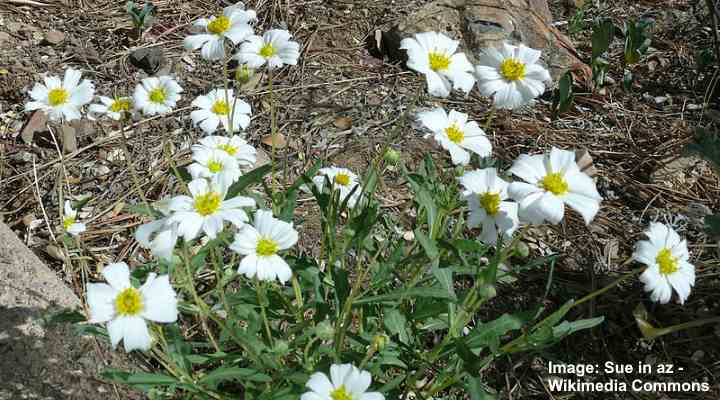
Blackfoot Daisy (Melampodium leucanthum)
Blackfoot daisy is a flowering plant you will commonly see growing in the wild in Texas prairies and meadows. The bushy mounding plant blooms with small daisy-like flowers. These dainty blooms have linear white petals surrounding a yellow central disc. The heat and drought-tolerant plant blooms from early spring until fall.
You can plant blackfoot daisies in sunny gardens and borders in a Texan garden. It is perfect for xeric landscaping.
USDA Growing Zones: 6 to 10.
Sun Exposure: Full sun or partial shade.
Height and Width: 6” to 12” (15 – 30 cm) tall and 12” to 24” (30 – 60 cm) wide.
Blue-Eyed Grass (Sisyrinchium spp.)
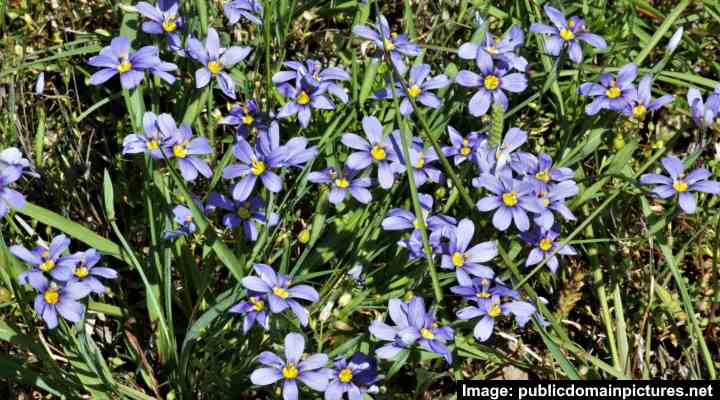
Blue-Eyed Grass (Sisyrinchium spp.)
Blue-eyed grass is a common wildflower that grows in open landscapes in Texas. The blanket-forming plant is identified by its violet-blue flowers, clumping grass-like foliage, and tolerance to heat and drought. In a naturalized informal garden, you can grow blue-eyed grass as a border front, edger for walkways, or add definition to a foundation planting.
USDA Growing Zones: 7 to 9.
Sun Exposure: Full sun or part shade.
Height and Width: 18” to 24” (45 – 60 cm) tall and 6” to 12” (15 – 30 cm) wide.
Tickseed or Coreopsis (Coreopsis spp.)
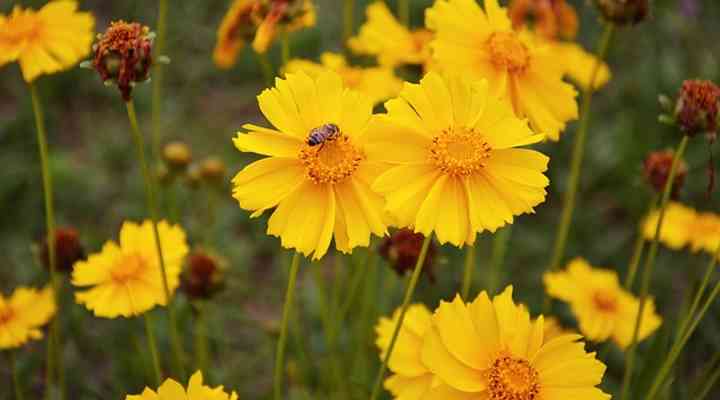
Tickseed or Coreopsis (Coreopsis spp.)
Coreopsis is a native Texas wildflower with eye-catching yellow flowers and an orange center. Various varieties of tickseed are always in bloom in most areas of the state apart from January. The plant grows as a bushy mound and is covered in daisy-like flowers when blooming.
In a southern garden, you can plant tickseed as in a perennial sunny border, patio container, or mass planting along a foundation line.
USDA Growing Zones: 7 to 10.
Sun Exposure: Full sun.
Height and Width: 5” to 7” (12 – 17 cm) tall and 12” to 24” (30 – 60 cm) wide.
Prickly Pear Cactus (Opuntia spp.)
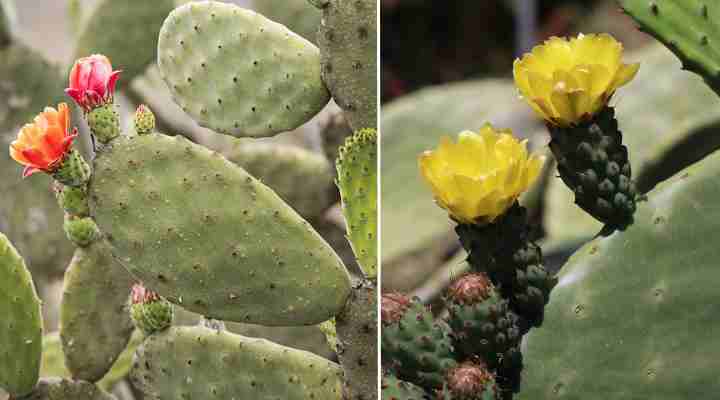
Prickly Pear Cactus (Opuntia spp.)
The prickly pear cactus is an iconic Texan desert plant that thrives in arid southern climates. The desert cactus has large paddle-like leaves converted in spiny thorns. When in bloom across the state, the cactus produces yellow and reddish showy flowers on top of its stems. After flowering, the shrubby cactus produces edible egg-shaped fruits.
USDA Growing Zones: 4 to 8.
Sun Exposure: Full sun.
Height and Width: 12” to 18” (30 – 45 cm).
Discover the most beautiful wildflowers to grow in a Texas garden.
Related articles:
- Texas Palm Trees – Identification Guide
- Desert Plants – Identification Guide
- Desert Flowers – Identification Guide
